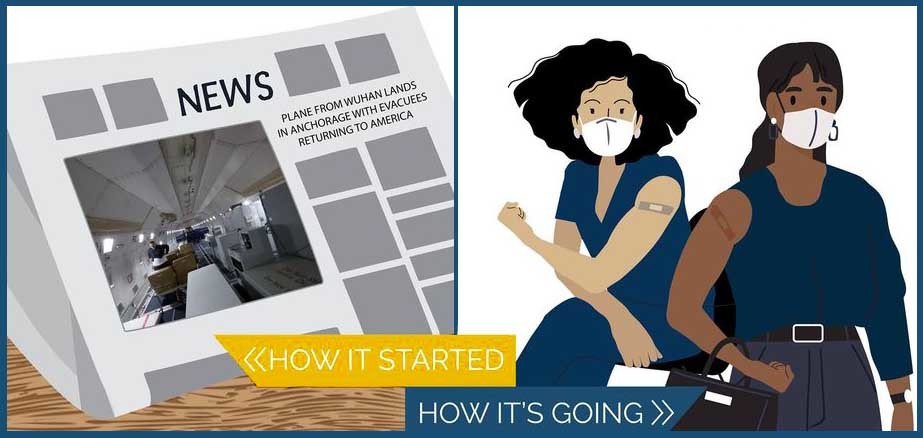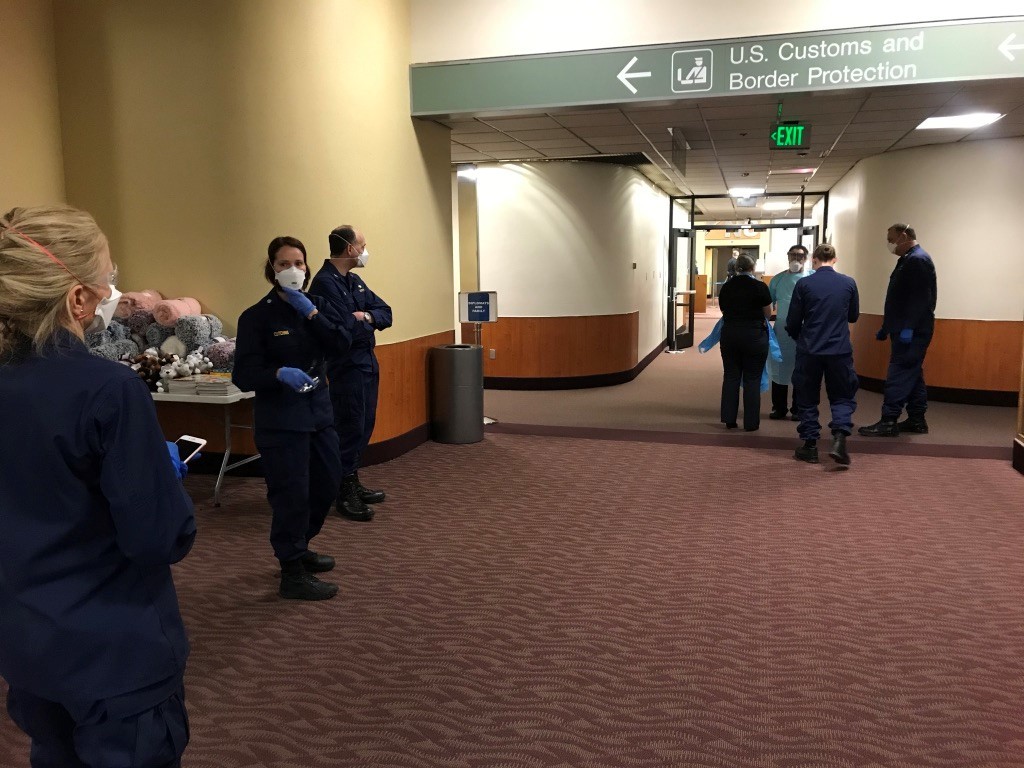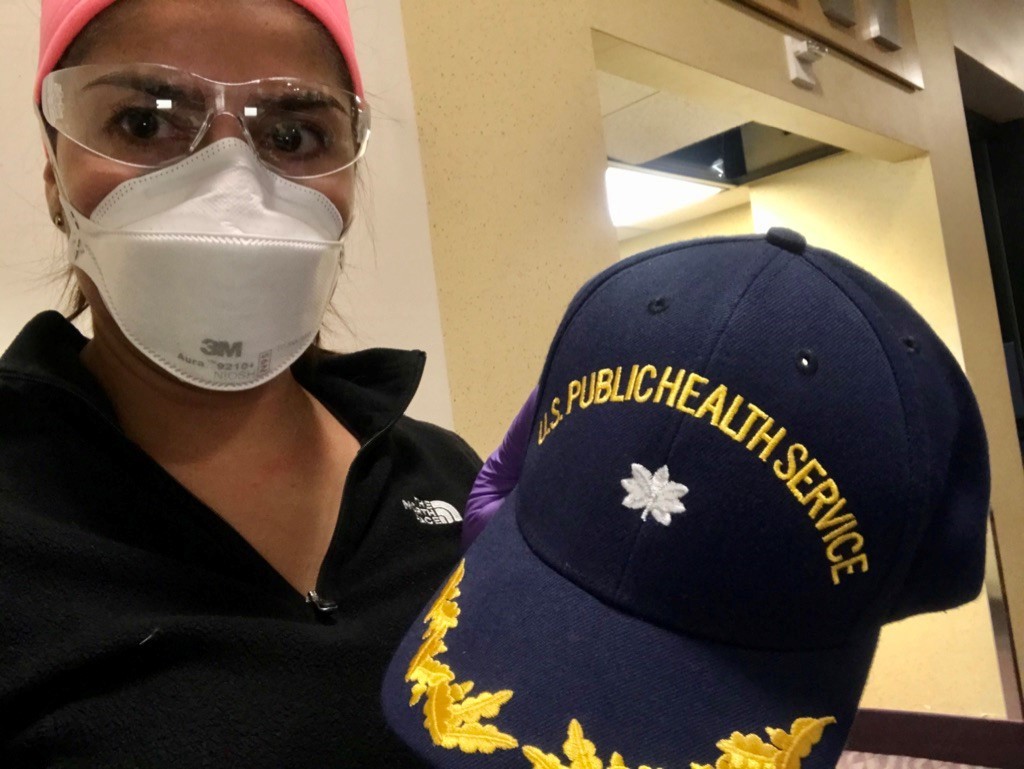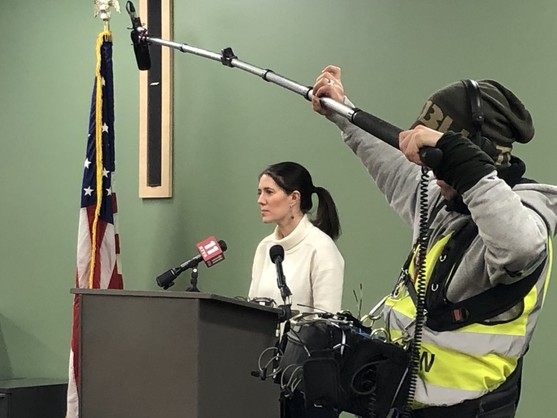Sign up for insights into DHSS's COVID-19 response
Subscribe to DHSS Insights for behind-the-scenes news about Alaska’s COVID-19 response and other efforts to protect the health and well-being of Alaskans. Stay strong, be safe, and protect yourself and others. Together we can stay on top of COVID!
Looking back on the Wuhan flight that landed in Alaska and marked the beginning of the state’s pandemic response

On Tuesday, Jan. 28, 2020, Kalitta flight #371 landed in Anchorage to refuel. This was no ordinary flight. Onboard were 201 American evacuees from Wuhan, China. The flight touched down at Ted Stevens Anchorage International Airport just before 9:30 p.m. It departed for California several hours later, just after 2 a.m. on Wednesday, Jan. 29, 2020.
The Kalitta flight was the first, and only, mission to stop in Anchorage to help Americans return to the country. Eventually, these types of U.S. State Department-supported flights returned more than 98,000 Americans evacuated from China and other locations hit hard during the pandemic by June 2021.
Alaska had just days to prepare for what was an uncertain and unsettling situation. The plane touched down in Anchorage for only a few hours. But looking back now, we recognize the Wuhan flight as a historic moment in time and the beginning of Alaska’s active response.
“There was a great deal of community fear and concern about the flight landing in Anchorage,” recalled Bill Kays, who was then the Anchorage Health Department’s incident commander. “The scientific and medical communities were racing to learn more about the illness. When the flight landed and the plane door opened, I could hear applause from inside the aircraft. The people aboard were very happy to be in the United States, and extremely grateful to the Alaskans who came out to greet them.”
The passengers disembarked in an area of the North Terminal closed to the public. They received health screenings, including multiple temperature checks. COVID-19 testing was not yet widely available and was not completed for these passengers in Anchorage.
Because they had to leave quickly and to help prevent the spread of disease, the passengers carried very little with them, leaving everything behind in Wuhan. Some also had to walk several miles to reach the airport in China, due to limited local transportation options. The stress of being in Wuhan during the outbreak and the process of leaving China was a harrowing experience for many. They shared these stories with Alaskans who helped the medical contractors who were also on the plane, overseeing the passengers and attending to any medical needs. The Red Cross donated blankets, food, bottled water, clothing, books, and toys to comfort passengers during their Anchorage layover.
After no passengers or crew showed symptoms of the virus, the plane was cleared to fly on to California. During an early morning media briefing held after the plane departed, Alaska’s Chief Medical Officer Dr. Anne Zink said passengers expressed “an overall sense of gratitude, excitement and relief.”
Dr. Zink said she also remembers feeling relieved when the plane departed.
“We had been told there was a medical emergency before the plane landed,” she recalled, noting that it ended up being a mild hand injury a passenger had sustained in the rush to Wuhan’s airport. “It was incredibly reassuring to have the plane leave with healthy, happy passengers and even more reassuring when everyone tested in California for the virus was negative and completed a 14-day quarantine with no positive cases.”
Of historical note, this was before quarantine laws had been enacted for this pandemic in the United States. The Alaska Department of Health and Social Service (DHSS) Jan. 29, 2020, press release stated that passengers would be re-screened in California and “temporarily housed for a period of time.” Two days later, U.S. health officials announced they would officially quarantine the U.S. citizens evacuated from Wuhan — the first time in 50 years that the Centers for Disease Control and Prevention (CDC) had taken such action.
Dr. Nancy Messonnier, director of CDC’s National Center for Immunization and Respiratory Diseases, told media then that the CDC was “preparing as if this is the next pandemic,” stressing that the agency hoped it would not become one.
 The landing forced Alaskans to act fast.
COVID-19 was first identified in Wuhan, China, in December 2019. Not much was known about the virus then. Cases were described as pneumonia from an unknown cause, but the virus was spreading quickly and resulting in many hospitalizations and deaths.
On Dec. 31, 2019, the first Wuhan cases were reported to the World Health Organization. On the same day, the U.S. Consulate General in Wuhan, China, convened an Emergency Action Committee to discuss the rumored outbreak of a respiratory illness. Soon after, plans began to form to help American citizens leave Wuhan and fly home.
On Jan. 17, 2020, the CDC and the Department of Homeland Security’s Customs and Border Protection (CBP) first announced that travelers from Wuhan to the United States would undergo health screening for symptoms associated with the disease then called the novel coronavirus (2019-nCoV). Discussions began to set up screening stations equipped to check temperatures at three U.S. airports where most Wuhan flights might land: San Francisco (SFO), New York (JFK) and Los Angeles (LAX). Anchorage (ANC) was not one of those early screening stations. Health officials here were actively monitoring the situation in Wuhan, China, but Anchorage was not yet on the map.
Just a few days later, on Jan. 21, the first novel coronavirus case in the United States was confirmed in Washington state — Alaska’s closest neighboring state. Then, on Jan. 23, Alaska’s public health officials heard that America’s first returning flight from China might need to land in Anchorage.
“I remember that first phone call on Jan. 25 from the U.S. Health and Human Services Administration for Children and Families,” said DHSS Commissioner Adam Crum. “It was the beginning of a series of calls between federal agencies and Alaska. There were many unknowns and as true Alaskans, we said ‘we will figure it out.’ We wanted to help bring Americans home.”
DHSS health officials briefed the Anchorage Health Department (AHD) that same day, Kays said. “I knew AHD was ready thanks to many training exercises with our state and CDC partners,” he said. “I was also part of the team that supported the repatriation flights of service members and their families from Japan following their deadly earthquake and tsunami in 2011. Several flights landed in Anchorage without incident. I knew Anchorage would rise to the occasion again.”
Hedberg said Alaska’s public health officials were candid with federal officials about the pros and cons of landing in Anchorage, including Alaska’s limited number of hospitals, ventilators and the need to sometimes transport patients out of state for complex medical care.
The team was first told the plane would land within days, but then it was delayed which provided more time to prepare. Dr. Zink said she recalls the challenge of needing to bring together many people quickly to work through possible scenarios. They examined every possible situation and angle to be prepared for anything, even the possibility that the plane’s passengers might need to disembark and stay for an undetermined amount of time in Anchorage.
At the same time, planning was complicated by security concerns that allowed the federal agencies to share only limited information. Zink, who is an emergency room physician, said it felt similar to being called to respond to a bad trauma case “knowing you have just a bit of time to lay everything out right, because a lot depends on every action once the person arrives, or in this case, the plane lands.”
 Encountering the virus early gave us valuable insight. We learned what was needed to stay safe.
Anchorage airport and Department of Transportation and Public Facilities staff; the CDC’s Quarantine Station at Ted Stevens International Airport; and many health professionals from DHSS, AHD and local hospitals all worked together to plan and support the mission. The Governor’s Office was provided with frequent updates to ensure strong coordination between all the state and federal partners.
Anchorage Health Department staff and DHSS epidemiology nurses volunteered to conduct the passenger screening. “Remember,” Kays said, “they volunteered with the knowledge that we did not know everything about the disease.
Most staff, except for those conducting the health screenings, were separated from the plane’s passengers and did not enter the area where the passengers took their layover. Personnel who did the screenings wore N95 masks, gloves and some also wore eye protection. Medical contractor staff onboard the plane who had the most interaction with passengers wore full PPE gear, including suits.
“One particular person who stood out to me was one of the airport attendees who was in charge of making sure everyone got on and off the plane as scheduled,” Dr. Zink recalled. “He shaved his beard so his N95 mask could be properly fit tested. He suited up. He had little medical experience, but he was committed to his job, eager to learn and ready to serve.”
 It was a wild ride, but an important one.
Looking back, Hedberg recalls how much was still unknown at that time: “We didn’t know very much about this novel coronavirus, so it was hard to gauge how much we should do or not. For example, we didn’t know if the virus was airborne, about symptomatic versus asymptomatic transmission and exactly what PPE we needed to use.”
When asked what her role was during the mission, Dr. Zink noted that she knew it would be her responsibility to “communicate back to our partners, Alaskans and the world how the mission went in the most truthful, honest way I could. I also say my role was to protect our team to be able to do the job they needed to do and that might mean taking media calls, getting additional resources and making sure backup plans were in place.”
Since then, Dr. Zink has become the primary “communicator in chief” for the pandemic.
Media interest in the flight was considerable, even extending internationally.
“My phone and email were blowing up with media wanting to know the latest information,” said DHSS Communications Director Clinton Bennett. “I was probably asked ‘when is the flight coming’ a million times.”
“I look back on the past year and I don’t know how so many people have been working so hard and fast, with minimal breaks, for so long,” he said. “Even a month or so after the flight, I still did not think this would be a year-long ordeal.”
Hedberg said she never imagined then “we would all be managing and navigating a historic pandemic.”
 We’ve had to ask a lot from our fellow Alaskans. Thank you for staying strong.
Compassion, empathy and cooperation have been critical since the beginning of this response. The pandemic has affected Alaskans and everyone nationally and globally in ways we will be learning about for years to come.
“I remember the stories of the people on the plane when they entered the airport,” Zink said. “There had been so much focus on the details of making sure the flight went off without any difficulty, but the humanity of the stories was striking and reminded me of why we do what do.”
“Alaskans have been tremendous through all this, and our team has also been phenomenal to work with. I feel like we’ve helped each other when anyone has floundered,” said Dr. Zink. "It’s been an exhausting year, she added, but what keeps her going are “my friends, my family, our community and a deep commitment to the health and wellbeing of those around me.”
Governor Mike Dunleavy issued a press release on Jan. 28, 2021, looking back on the flight that included the following statement: “We avoided the dark future that many health experts predicted, including forecasts of 14,000 hospitalizations and 10,000 deaths. To date, we have seen 1,200 hospitalizations and 259 Alaska resident deaths. We mourn the loss of each life, and our deepest sympathies are extended to their families and loved ones. We have learned a lot this past year. As a result of the actions taken by Alaskans, and the emergency team in this administration, Alaska now leads the nation in vaccinations and has some of the lowest hospitalization and death rates in the country. Against all odds, Alaska is leading the way during this pandemic.”
“This entire response has been about us pulling together and supporting each other, from frontline workers through to the governor’s office,” Hedberg added. “While we all have different perspectives, we’re able to unite and have had each other’s backs, which is a really nice feeling as we keep heading into the unknown.”
There are future lessons, too, in this sprint that will last beyond this pandemic. “I think it highlights the need to have a robust public health response ready to handle whatever may arise,” Dr. Zink added. “There will be other large issues ahead, but just as this flight helped prepare us to better handle our first cases, I also believe Alaska is more prepared now to handle any future public health challenges.”
|